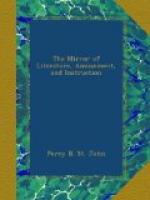A narrower passage leads to a charming breakfast room, which looks to the Tweed on one side, and towards Yarrow and Ettricke, famed in song, on the other: a cheerful room, fitted up with novels, romances, and poetry, I could perceive, at one end; and the other walls covered thick and thicker with a most valuable and beautiful collection of watercolour drawings, chiefly by Turner and Thomson of Duddingstone, the designs, in short, for the magnificent work entitled “Provincial Antiquities of Scotland.” There is one very grand oil painting over the chimney-piece, Fastcastle, by Thomson, alias the Wolf’s Crag of the Bride of Lammermoor, one of the most majestic and melancholy sea-pieces I ever saw; and some large black and white drawings of the Vision of Don Roderick, by Sir James Steuart of Allanbank (whose illustrations of Marmion and Mazeppa you have seen or heard of), are at one end of the parlour. The room is crammed with queer cabinets and boxes, and in a niche there is a bust of old Henry Mackenzie, by Joseph of Edinburgh. Returning towards the armoury, you have, on one side of a most religious looking corridor, a small greenhouse, with a fountain playing before it—the very fountain that in days of yore graced the cross of Edinburgh, and used to flow with claret at the coronation of the Stuarts—a pretty design, and a standing monument of the barbarity of modern innovation. From the small armoury you pass, as I said before, into the drawing-room, a large, lofty, and splendid salon, with antique ebony furniture and crimson silk hangings, cabinets, china, and mirrors quantum suff, and some portraits; among the rest glorious John Dryden, by Sir Peter Lely, with his gray hairs floating about in a most picturesque style, eyes full of wildness, presenting the old Bard, I take it, in one of those “tremulous moods,” in which we have it on record he appeared when interrupted in the midst of his Alexander’s Feast. From this you pass into the largest of all the apartments, the library, which, I must say, is really a noble room. It is an oblong of some fifty feet by thirty, with a projection in the centre, opposite the fireplace, terminating in a grand bow window, fitted up with books also, and, in fact, constituting a sort of chapel to the church. The roof is of carved oak again—a very rich pattern—I believe chiefly a la Roslin, and the bookcases, which are also of richly carved oak, reach high up the walls all round. The collection amounts, in this room, to some fifteen or twenty thousand volumes, arranged according to their subjects: British history and antiquities, filling the whole of the chief wall; English poetry and drama, classics and miscellanies, one end: foreign literature, chiefly French and German, the other. The cases on the side opposite the fire are wired and locked, as containing articles very precious and very portable. One consists entirely of books and MSS. relating to the insurrections of 1715 and 1745; and another (within




